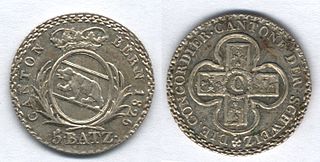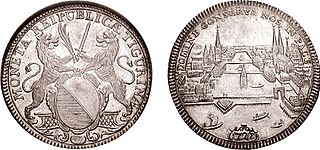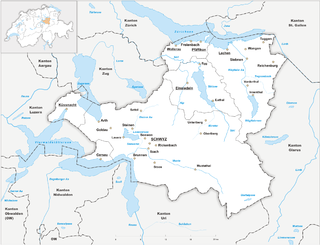
The schilling was the currency of Austria from 1925 to 1938 and from 1945 to 1999, and the circulating currency until 2002. The euro was introduced at a fixed parity of €1 = 13.7603 schilling to replace it. The schilling was divided into 100 groschen.

The Vereinsthaler was a standard silver coin used in most German states and the Austrian Empire in the years before German unification.
The Gulden was the currency of Württemberg until 1873. Until 1824, the Gulden was a unit of account and was used to denominate banknotes but was not issued as a coin. It was worth 5⁄12 of a Conventionsthaler and was subdivided into 50 Conventionskreuzer or 60 Kreuzer Landmünze.

The Frank was the currency of the Swiss canton of Aargau between 1798 and 1850. It was subdivided into 10 Batzen, each of 4 Kreuzer or 10 Rappen.

The Basel Thaler was the currency of the Swiss Canton of Basel until 1798. The currency was issued by both the Canton and the Bishopric of Basel.
The Basel frank was the currency of the Swiss canton of Basel between 1798 and 1850.

The Frank was the currency of the Swiss canton of Berne between 1798 and 1850. It was subdivided into 10 Batzen, each of 10 Rappen.
The Gulden was the currency of the Swiss canton of Fribourg until 1798. It was subdivided into 14 Batzen, each of 4 Kreuzer or 16 Denier. It was replaced by the Frank of the Helvetian Republic in 1798. This was, in turn, replaced by the Fribourg Frank.
The Frank was the currency of the Swiss canton of Fribourg between 1798 and 1850. It was subdivided into 10 Batzen, each of 4 Kreuzer or 10 Rappen.
The Frank was the currency of the Swiss canton of Glarus between 1798 and 1850. It was subdivided into 100 Rappen, with the Schilling worth 3 Rappen.

The Frank was the currency of the Swiss canton of Luzern between 1798 and 1850. It was subdivided into 10 Batzen, each of 10 Rappen or 20 Angster.
The gulden was the currency of the Swiss canton of Luzern until 1798. It was subdivided into 40 schilling, each of 3 rappen or 6 angster. Coins were also issued denominated in kreuzer and batzen. It was replaced by the franc of the Helvetian Republic in 1798. This was, in turn, replaced by the Luzern frank.
The Thaler was the currency of St. Gallen until 1798. It was subdivided into 2 Gulden, each of 60 Kreuzer or 240 Pfennig. It was replaced by the Frank of the Helvetian Republic in 1798. This was, in turn, replaced by the St. Gallen Frank. Coins were issued by both the Abbey of St. Gall and the City.
The Frank was the currency of the Swiss canton of Schaffhausen between 1798 and 1850. It was subdivided into 10 Batzen, each of 4 Kreuzer.
The Frank was the currency of the Swiss canton of Schwyz between 1798 and 1850. It was subdivided into 10 Batzen, each of 10 Rappen or 20 Angster.
The Frank was the currency of the Swiss canton of Solothurn between 1798 and 1850. It was subdivided into 10 Batzen, each of 4 Kreuzer or 10 Rappen.
The Frank was the currency of the Swiss canton of Thurgau between 1798 and 1803. It was subdivided into 10 Batzen, each of 4 Kreuzer.
The Frank was the currency of the Swiss canton of Uri between 1798 and 1850. It was subdivided into 10 Batzen, each of 10 Rappen.

The Thaler was the currency of Zürich until 1798. It was subdivided into 2 Gulden, each of 36 Schillinge, with the Schilling divided into 4 Rappen or 12 Haller. It was replaced by the Frank of the Helvetian Republic in 1798. This was, in turn, replaced by the Zürich Frank. The thaler was worth 1⁄11 of a Cologne mark.

The Frank was the currency of the Swiss canton of Zürich between 1798 and 1850. It was subdivided into 10 Batzen, each of 10 Rappen, with 3 Heller to the Rappen and 4 Rappen to the Schilling.










